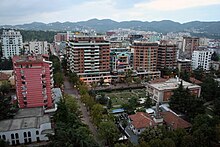Blloku
Blloku ( Albanian also Bllok ) is a district in the center of the Albanian capital Tirana .
location
Blloku within Tirana |
The district is located just south of the Lana and west of the main street Bulevardi Dëshmorët e Kombit . The original part was bordered by Rruga Sami Frashëri to the west and by Rruga Abdyl Frashri to the south. Today, small areas further south and west to the Selman Stërmasi Stadium are also included in the Blloku.
history
The area south of the Lana was not incorporated into town planning until the 1930s, when the young capital was developing rapidly, and gradually opened up with the construction of the boulevard and some government buildings. Most of the villas were built in the Blloku area. Around 1940 there were only a few houses here.
After the Second World War and the Communists came to power, the owners of the houses in Blloku were expropriated. The area became a closed off residential area for the government of Albania - similar to Wandlitz near Berlin. The public had no access to this area in the heart of Tirana, which was shielded from soldiers. Only the nomenklatura of the Socialist People's Republic operated here. The residents of the neighborhood included Enver Hoxha , Hysni Kapo , Mehmet Shehu , Manush Myftiu , Beqir Balluku , Koço Theodhosi , Ramiz Alia , Rita Marko , Haki Toska , Xhafer Spahiu and Spiro Koleka .
After the collapse of the communist system, some of the now vacant houses were taken over by international organizations. The first cafés were soon set up in the open spaces in the district, and tall houses were later built.
present
The quarter is now an entertainment district with numerous bars, restaurants, cafes, hotels and shops. The Sky Tower in the middle of the quarter was once the tallest building in Albania. Right next to it are the Swiss and Russian embassies. On Boulevard Dëshmort e Kombit, at the entrance to the district, there are government buildings, parliamentary offices and parks, including the Postbllok monument, which commemorates the crimes of communist rule.
Enver Hoxha's villa is still empty and is guarded by soldiers. Mehmet Shehu's villa is now a government guest house.
“The Albanian youth have recaptured Blloku. The block district, in which the communist functionaries once hid from the people, is loud and cheeky. The villa of the ex-dictator Enver Hodscha ducks intimidated in this hustle and bustle, a meek monument of communist tyranny. "
Individual evidence
- ↑ Besnik Aliaj, Keida Lulo, Genc Myftiu: Tirana - The Challenge of Urban Development . Tirana 2003, ISBN 99927-880-0-3 .
- ↑ a b ABC Story (ABC News): Si u grabiten villat e bllokut on YouTube , January 27, 2016, accessed on November 25, 2018.
- ↑ See the city map from 1938 in Pirro Marconi, Sestilio Montanelli et al .: Albania . Ed .: Consociazione Turistica Italiana (= Guida d'Italia . No. 25 ). Unione tipografica, Milan 1940, p. after 152 ( online version in Google Book Search [accessed November 25, 2018]). , the city map m from 1943 in Adolph Stiller (Ed.): Tirana (= Architecture in the Ringturm . Volume XXII ). Müry Salzmann Verlag, Salzburg / Vienna 2010, ISBN 978-3-99014-030-7 , p. 42 . and the aerial photo ibid., p. 27.
- ↑ Sean Williams: Albania's Block party: Dancing away the dictator's legacy. In: CNN. September 12, 2014, accessed November 25, 2018 .
- ↑ Susanne Stiefel: Tirana . In: Süddeutsche Zeitung Magazin . No. 35 , 2007 ( sueddeutsche.de [accessed November 25, 2018]).
Coordinates: 41 ° 19 ′ 15 ″ N , 19 ° 48 ′ 59 ″ E



